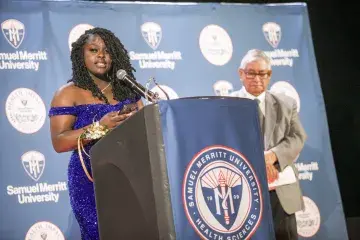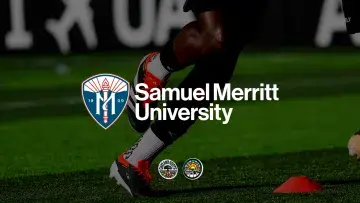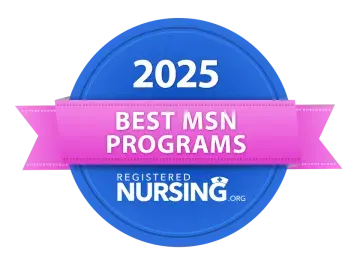Hypertension Sunday Offers Students New View on Healthcare Education
Of all the things written onto a long to-do list for Sunday morning, Sarah Reyes did not write, “Get screened for high blood pressure and hypertension.” And yet, the 43-year-old mother of three saw the opportunity awaiting her as she stepped out of Acts Full Gospel Church in East Oakland.
“It’s not something I’d ever think about,” said Reyes, “but if it’s sitting right here for free, I might as well get it checked out.”
Reyes was one of an estimated 700 residents who received free health screenings outside churches across the East Bay at the annual Hypertension Sunday event hosted by Samuel Merritt University’s Ethnic Health Institute (EHI) Feb. 26.
The annual event, named in honor of its founder Dr. Frank E. Staggers Sr., started more than 20 years ago and aims to educate residents about the risks of high blood pressure and whether they’re showing signs of hypertension, often called the “silent killer” because people can have it for years without symptoms, yet it can lead to serious health problems like heart attack and stroke. African Americans are more likely than any other racial or ethnic group to have the dangerous condition and to develop it earlier in life.
To coordinate the free screenings held in collaboration with 25 churches throughout Alameda and Contra Costa counties, EHI brought together a coalition of 200 volunteers including health care professionals, community partners, and 40 student volunteers and faculty from SMU.
“In addition to community health outreach and education, mentoring young people was a passion of Dr. Staggers, Sr. and is emphasized in our approach to teaming students of all levels with experienced health professionals on Hypertension Sunday,” said Arlene Swinderman, Director of EHI.
Faculty advisor Lorraine Mautner, MSN, RN, said the event was one of many that allow SMU students a unique opportunity to expand their healthcare education outside the classroom and experience firsthand the need for preventative care in underserved communities.
“This shows students that nursing isn’t just acute care in a hospital,” Mautner said. “This kind of event holds a lot more value for the students. It shows them how important it is to prevent admissions to the hospital; this shows them the critical link they don’t see if they just start working in the ICU.”
Dr. Frank E. Staggers Jr., the son of the event’s namesake, said the event also gives SMU students an unexpected supplement to their classroom learning, as it places them side-by-side with working professionals.
“I call it I.M.O.,” Staggers Jr. said. “Inspiration, motivation, outreach. It allows people on all spectrums of the healthcare profession – from retired doctors to young students – to come together and learn new things from each other. The old doctor shows the student tried-and-true methods, but the students also show the doctor new tricks.”
At Creekside Community Church in San Leandro, ELMSN student Milissa Buriel conducted more than a dozen blood pressure screenings and offered resources to residents about how to prevent and manage hypertension.
Buriel said the experience taught her about the immediate connection made between healthcare provider and patient, and how important that bond is to create change.
“Patient interaction, unfortunately, can't be taught in the classroom,” Buriel said. “This experience has helped me create an important foundation. I learned different methods to communicate and provide understanding during those interactions.”
Luckily, some patients like Reyes at Acts Full Gospel received good news: Normal blood pressure and no signs of the silent killer at work.
Staggers Jr. said that over the years there have been times when he was forced to request an ambulance for people who showed blood pressure at “near stroke” levels.
“It’s important for students to get this perspective because they learn that healthcare providers are not independent of the community, but of the community,” Staggers said. “It’s not asking the community to come to the ivory tower; it’s where the ivory tower comes to the community.”


